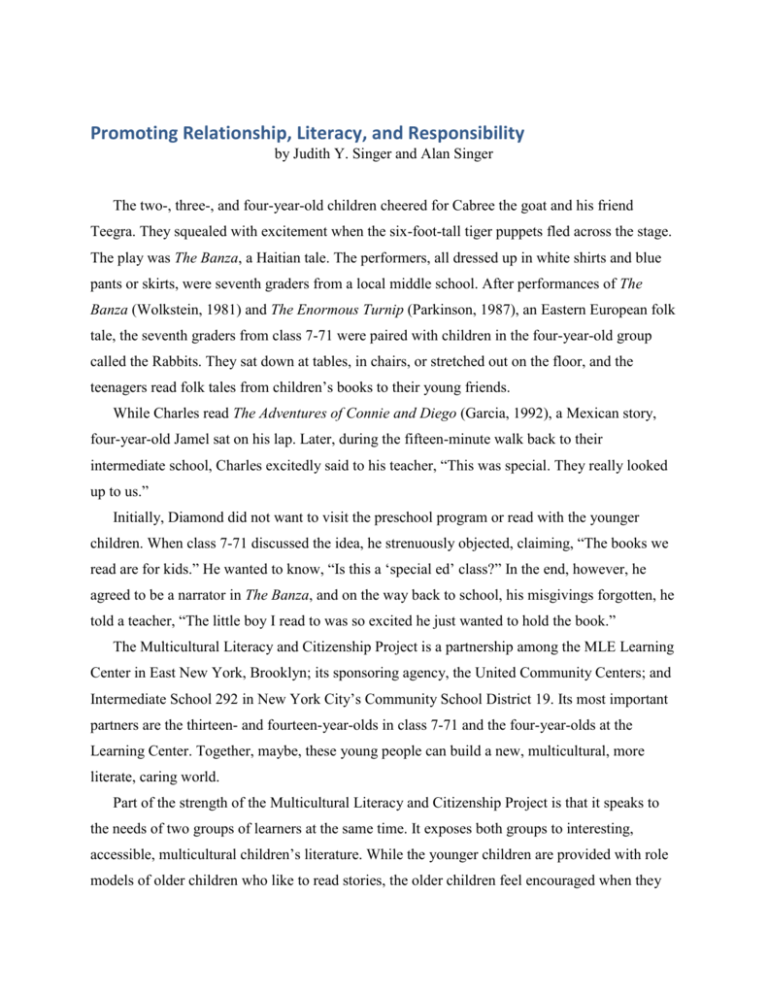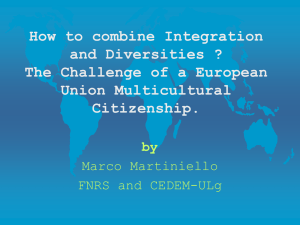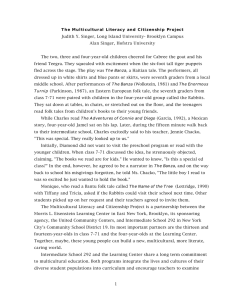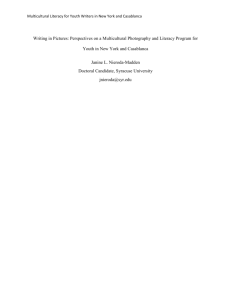Promoting Relationship, Literacy, and Responsibility
advertisement

Promoting Relationship, Literacy, and Responsibility by Judith Y. Singer and Alan Singer The two-, three-, and four-year-old children cheered for Cabree the goat and his friend Teegra. They squealed with excitement when the six-foot-tall tiger puppets fled across the stage. The play was The Banza, a Haitian tale. The performers, all dressed up in white shirts and blue pants or skirts, were seventh graders from a local middle school. After performances of The Banza (Wolkstein, 1981) and The Enormous Turnip (Parkinson, 1987), an Eastern European folk tale, the seventh graders from class 7-71 were paired with children in the four-year-old group called the Rabbits. They sat down at tables, in chairs, or stretched out on the floor, and the teenagers read folk tales from children’s books to their young friends. While Charles read The Adventures of Connie and Diego (Garcia, 1992), a Mexican story, four-year-old Jamel sat on his lap. Later, during the fifteen-minute walk back to their intermediate school, Charles excitedly said to his teacher, “This was special. They really looked up to us.” Initially, Diamond did not want to visit the preschool program or read with the younger children. When class 7-71 discussed the idea, he strenuously objected, claiming, “The books we read are for kids.” He wanted to know, “Is this a ‘special ed’ class?” In the end, however, he agreed to be a narrator in The Banza, and on the way back to school, his misgivings forgotten, he told a teacher, “The little boy I read to was so excited he just wanted to hold the book.” The Multicultural Literacy and Citizenship Project is a partnership among the MLE Learning Center in East New York, Brooklyn; its sponsoring agency, the United Community Centers; and Intermediate School 292 in New York City’s Community School District 19. Its most important partners are the thirteen- and fourteen-year-olds in class 7-71 and the four-year-olds at the Learning Center. Together, maybe, these young people can build a new, multicultural, more literate, caring world. Part of the strength of the Multicultural Literacy and Citizenship Project is that it speaks to the needs of two groups of learners at the same time. It exposes both groups to interesting, accessible, multicultural children’s literature. While the younger children are provided with role models of older children who like to read stories, the older children feel encouraged when they realize that they can be role models. The middle school students also have the opportunity to read literature they can successfully navigate without feeling stigmatized as slow readers. At I.S. 292, students were introduced to the Multicultural Literacy and Citizenship Project during a discussion where they were asked to define “multicultural,” “literacy,” and “citizenship.” Outside observers might look at class 7-71 and see only a room full of black and brown faces. But the seventh graders quickly identified their cultural similarities and differences. They all live in East New York, Brooklyn, and they each speak either English or English and Spanish. They also have relatives from many different parts of the world, including the U.S. South, South and Central America, the United Kingdom, Jamaica, Puerto Rico, the Dominican Republic, and Haiti. While defining “multicultural” was not hard for these students, understanding the relationship between citizenship and the literacy project was a problem. Most of the students were native-born citizens of the United States. They all could identify themselves as citizens of I.S. 292 and class 7-771; however, for them, citizenship means membership and obeying rules. The idea of taking responsibility for others was something they reserved for their families. Some of the students initially insisted that “we should be paid to volunteer,” but they each eventually decided that they were willing to volunteer “to do something important,” and 100 percent of the class returned signed permission slips allowing them to visit the preschool program. The students in class 7-71 know that they do not perform very well in school, so what they had the greatest difficulty understanding was why their class was being asked to participate in the project. When they found out that their job as literacy volunteers was to help young children in a local day care center learn to read, their collective reaction was, “Why are you asking us?” The answers they arrived at through discussion were that “this is something we can do well”; “the young children need our help”; and “practicing reading and writing can help us, too.” Some of the teachers in the school also could not understand why this group of students was invited to participate in the project. One staff member told organizers, “if you realized how bad these children are, you would never trust them with the little ones.” The Multicultural Literacy and Citizenship Project supports many important educational goals. It encourages student interest in understanding the culturally diverse nature of our world and uses their interest to stimulate literacy. Working as literacy volunteers with young children promotes an interest in reading and writing among middle school students, while the relationship with the older students increases the desire of the younger children to learn to read and write. It has also helped “discouraged” youngsters develop personal and supportive relationships with teachers and other adults in their community.









